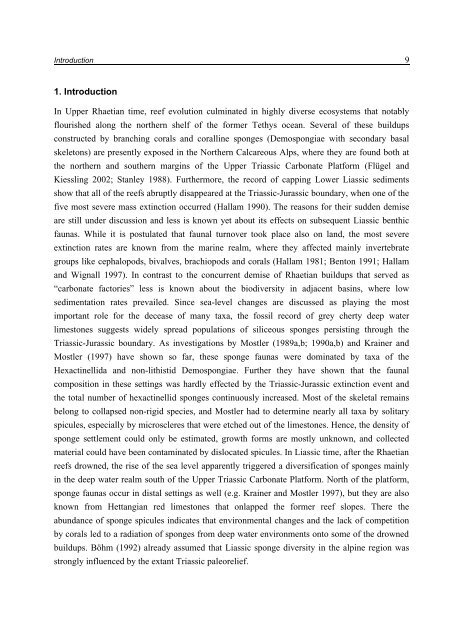Porifera-microbialites of the Lower Liassic (Northern Calcareous ...
Porifera-microbialites of the Lower Liassic (Northern Calcareous ...
Porifera-microbialites of the Lower Liassic (Northern Calcareous ...
Create successful ePaper yourself
Turn your PDF publications into a flip-book with our unique Google optimized e-Paper software.
Introduction 9<br />
1. Introduction<br />
In Upper Rhaetian time, reef evolution culminated in highly diverse ecosystems that notably<br />
flourished along <strong>the</strong> nor<strong>the</strong>rn shelf <strong>of</strong> <strong>the</strong> former Tethys ocean. Several <strong>of</strong> <strong>the</strong>se buildups<br />
constructed by branching corals and coralline sponges (Demospongiae with secondary basal<br />
skeletons) are presently exposed in <strong>the</strong> Nor<strong>the</strong>rn <strong>Calcareous</strong> Alps, where <strong>the</strong>y are found both at<br />
<strong>the</strong> nor<strong>the</strong>rn and sou<strong>the</strong>rn margins <strong>of</strong> <strong>the</strong> Upper Triassic Carbonate Platform (Flügel and<br />
Kiessling 2002; Stanley 1988). Fur<strong>the</strong>rmore, <strong>the</strong> record <strong>of</strong> capping <strong>Lower</strong> <strong>Liassic</strong> sediments<br />
show that all <strong>of</strong> <strong>the</strong> reefs abruptly disappeared at <strong>the</strong> Triassic-Jurassic boundary, when one <strong>of</strong> <strong>the</strong><br />
five most severe mass extinction occurred (Hallam 1990). The reasons for <strong>the</strong>ir sudden demise<br />
are still under discussion and less is known yet about its effects on subsequent <strong>Liassic</strong> benthic<br />
faunas. While it is postulated that faunal turnover took place also on land, <strong>the</strong> most severe<br />
extinction rates are known from <strong>the</strong> marine realm, where <strong>the</strong>y affected mainly invertebrate<br />
groups like cephalopods, bivalves, brachiopods and corals (Hallam 1981; Benton 1991; Hallam<br />
and Wignall 1997). In contrast to <strong>the</strong> concurrent demise <strong>of</strong> Rhaetian buildups that served as<br />
“carbonate factories” less is known about <strong>the</strong> biodiversity in adjacent basins, where low<br />
sedimentation rates prevailed. Since sea-level changes are discussed as playing <strong>the</strong> most<br />
important role for <strong>the</strong> decease <strong>of</strong> many taxa, <strong>the</strong> fossil record <strong>of</strong> grey cherty deep water<br />
limestones suggests widely spread populations <strong>of</strong> siliceous sponges persisting through <strong>the</strong><br />
Triassic-Jurassic boundary. As investigations by Mostler (1989a,b; 1990a,b) and Krainer and<br />
Mostler (1997) have shown so far, <strong>the</strong>se sponge faunas were dominated by taxa <strong>of</strong> <strong>the</strong><br />
Hexactinellida and non-lithistid Demospongiae. Fur<strong>the</strong>r <strong>the</strong>y have shown that <strong>the</strong> faunal<br />
composition in <strong>the</strong>se settings was hardly effected by <strong>the</strong> Triassic-Jurassic extinction event and<br />
<strong>the</strong> total number <strong>of</strong> hexactinellid sponges continuously increased. Most <strong>of</strong> <strong>the</strong> skeletal remains<br />
belong to collapsed non-rigid species, and Mostler had to determine nearly all taxa by solitary<br />
spicules, especially by microscleres that were etched out <strong>of</strong> <strong>the</strong> limestones. Hence, <strong>the</strong> density <strong>of</strong><br />
sponge settlement could only be estimated, growth forms are mostly unknown, and collected<br />
material could have been contaminated by dislocated spicules. In <strong>Liassic</strong> time, after <strong>the</strong> Rhaetian<br />
reefs drowned, <strong>the</strong> rise <strong>of</strong> <strong>the</strong> sea level apparently triggered a diversification <strong>of</strong> sponges mainly<br />
in <strong>the</strong> deep water realm south <strong>of</strong> <strong>the</strong> Upper Triassic Carbonate Platform. North <strong>of</strong> <strong>the</strong> platform,<br />
sponge faunas occur in distal settings as well (e.g. Krainer and Mostler 1997), but <strong>the</strong>y are also<br />
known from Hettangian red limestones that onlapped <strong>the</strong> former reef slopes. There <strong>the</strong><br />
abundance <strong>of</strong> sponge spicules indicates that environmental changes and <strong>the</strong> lack <strong>of</strong> competition<br />
by corals led to a radiation <strong>of</strong> sponges from deep water environments onto some <strong>of</strong> <strong>the</strong> drowned<br />
buildups. Böhm (1992) already assumed that <strong>Liassic</strong> sponge diversity in <strong>the</strong> alpine region was<br />
strongly influenced by <strong>the</strong> extant Triassic paleorelief.

















